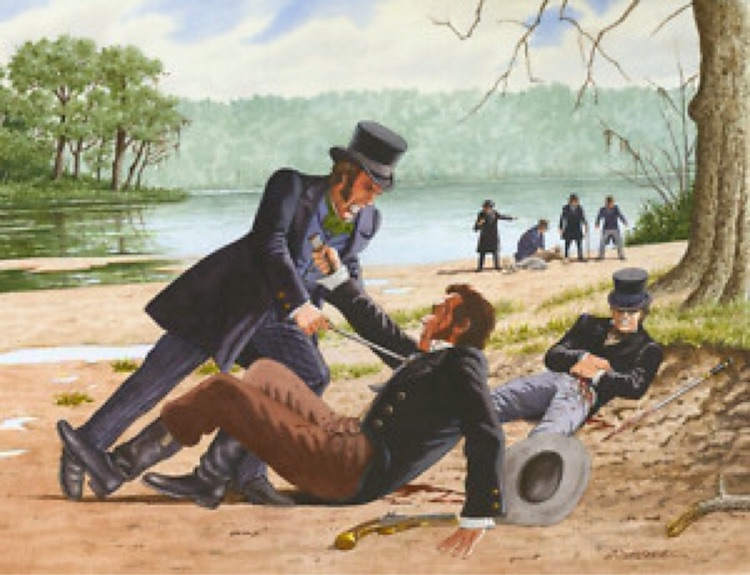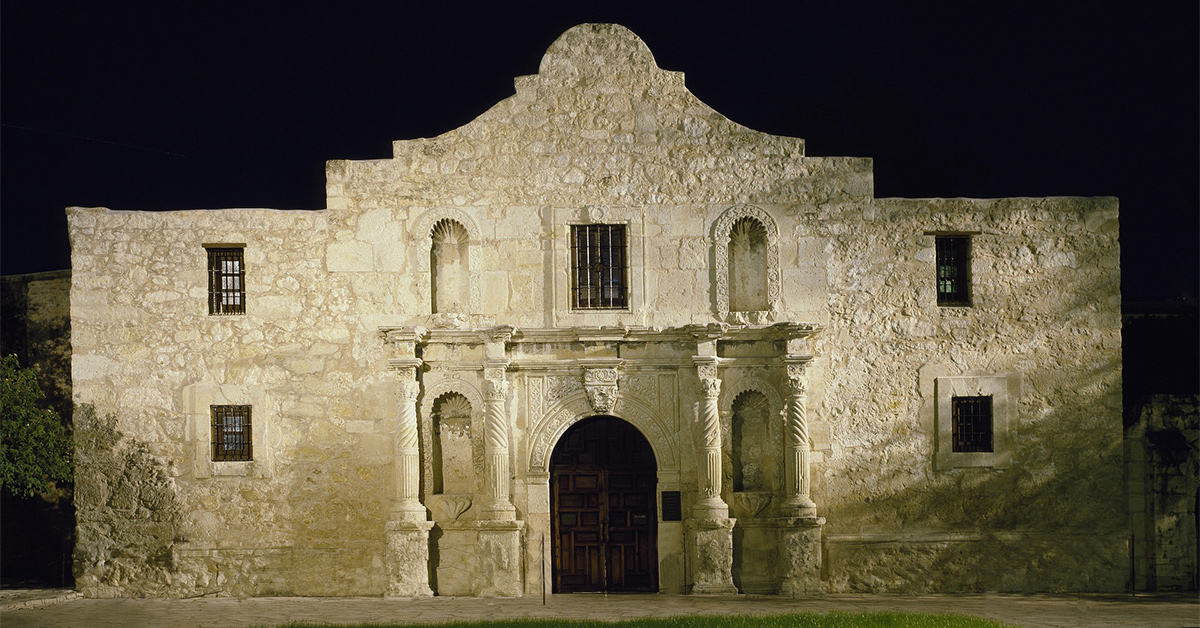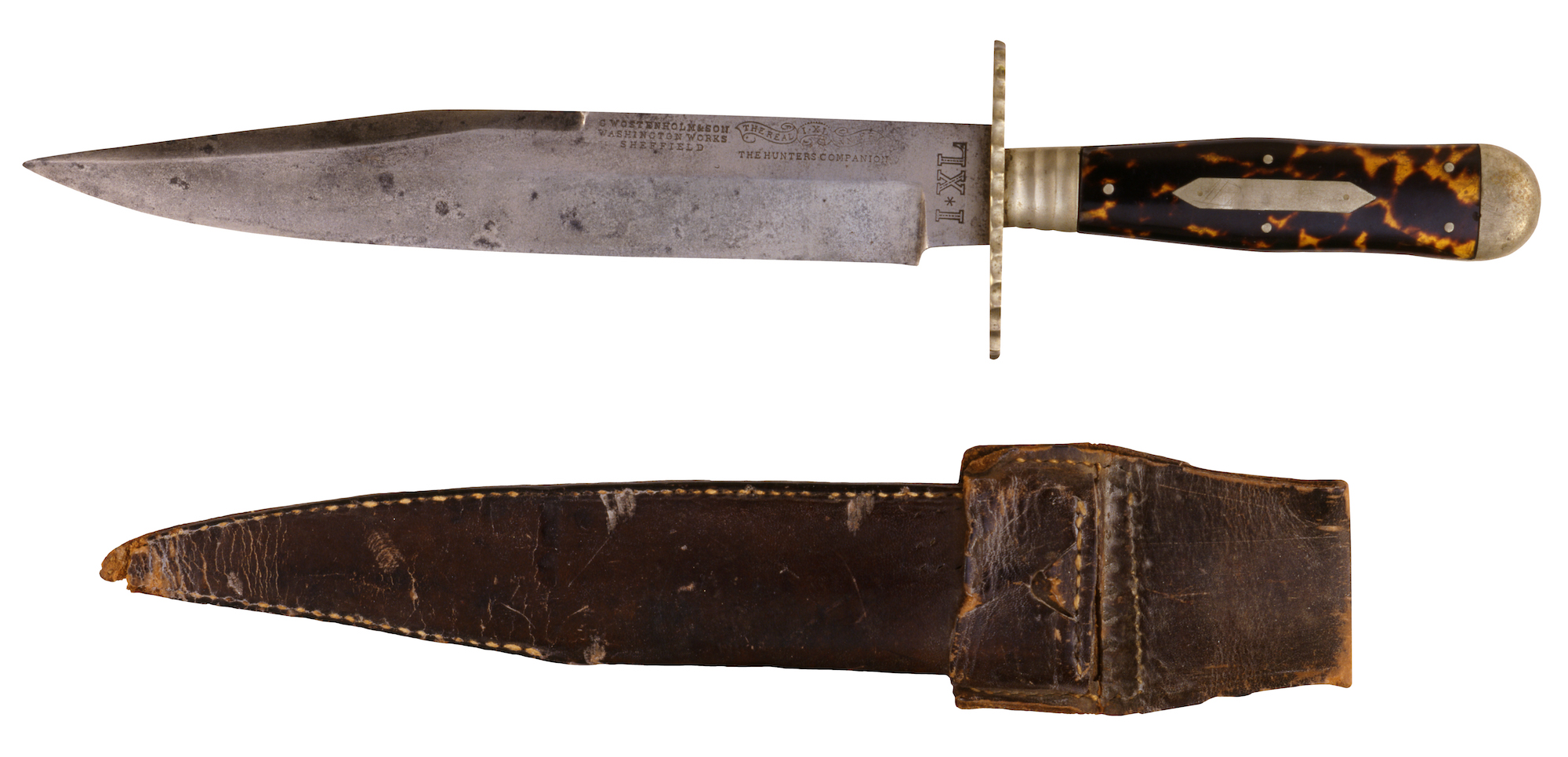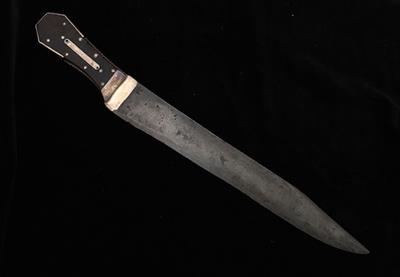It must be long enough to be a sword, sharp enough to use as a razor, wide enough to use as a paddle, and heavy enough to use as a hatchet.
That quote from a historian perfectly sums up the versatility and diversity of design represented in the legendary Bowie knife.
There is no single item with a stronger connection to the American experiment than the Bowie knife. So where exactly did the Bowie knife come from and just what is a Bowie knife? We’re here to answer your questions.
What is a Bowie Knife?
Before we delve deeper into the history of the knife, here’s what the experts say is the consensus Bowie knife design.
…
I fooled you. There isn’t one. Different historians and knife enthusiasts will tell you different things. Some say any large knife with a blade exceeding five inches is a Bowie knife. Other says a Bowie knife must have a double-edged point.
In general, most would say a Bowie knife is a large fixed blade (although you will find the occasional folding Bowie like the Spyderco Slysz Bowie) with a clip point blade. A hand guard is often a staple of the Bowie but not necessary.
This Winchester Bowie is something that’s reminiscent of a knife people think you would see in the old American frontier.
I wouldn’t say it’s the quintessential Bowie knife because there are better quality versions out there, but this is what many see when they think Bowie knife.
The Man Behind the Knife
It’s impossible to trace the lineage of the famed Bowie knife without an earnest look at the knife’s namesake: James Bowie. Back in 2010, one of the contributors to this blog wrote a nice profile about Bowie, but it’s important to provide some context.
James Bowie, who was more commonly known as Jim Bowie, was born in Kentucky in 1796 and spent much of his life in Louisiana. His name is pronounced boo-E, but it’s not uncommon to see it pronounced bO-e (as in David Bowie). He was one of 10 children and born to a veteran of the Revolutionary War.
During Bowie’s childhood and adolescence, the United States was still a very young country at about 30 years of age. Society was still in flux and going through vast changes. When Bowie was born, the entire western portion of the country still belonged to the French and Spanish. But, with the Louisiana Purchase in the early 1800s, America started expanded westward.
Bowie and his brother Rezin joined the Louisiana militia in 1814 to fight the British in the War of 1812 but had missed the fighting by the time they arrived. After joining the Long Expedition to liberate Texas from Spanish control in 1819, he became a land speculator and illegitimately made money by selling land in the frontier.
The Origins of the Bowie Knife
Due to poorly kept history during that time, the true origins and early timeline of the iconic knife likely died nearly 200 years ago. But one account says Jim’s brother Rezin Bowie designed the first Bowie knife after cutting his fingers while skinning a rabbit in the mid 1820s.
Rezin had Jesse Clift make the Bowie, which was later described as a 9.5-inch knife that resembled a large butcher knife without a clip point or hand guard. Some of this stuff came from Rezin after the knife became famous, so it’s hard to separate the facts from the myth.
Most historians agree that the Bowie knife was never just a single design but an evolution of designs that the Bowies improved upon over the years. The knife evolved a little more before it was propelled to fame with Jim Bowie about a year later during the famous Sandbar Fight.
Sandbar Fight of 1827
By 1827, the roughly 31-year-old Jim Bowie already had a reputation as a badass frontiersman who you shouldn’t mess with, but it was the Sandbar Fight that solidified his reputation. This has been covered countless times, so I’ll just go over the basics.

On Sept. 19, 1827, a one-on-one duel between Samuel L. Wells III and Dr. Thomas H. Maddox took place on a sandbar in the Mississippi River near Vidalia, Louisiana. The two were settling a host of disputes. Duels were a serious matter that included negotiations, supporters, and the presence of surgeons. Bowie was there to support Wells. During the duel, the two men each fired two shots at one another but neither man was injured, so the duel was resolved with a handshake.
The fight was far from over, however.
The two parties went on to celebrate their survival when all hell broke lose. Although there’s a discrepancy in the accounts, we know a brawl erupted between the two factions. Two men were left dead and two were severely injured, including Bowie. He was shot and stabbed multiple times but still managed to draw his large sheathed knife and kill his rival.
Despite suffering gunshot wounds and stabs, Bowie managed to survive the incident. One doctor reportedly said, “How he lived is a mystery to me, but live he did.”
Aftermath of the Sandbar Fight
The press covered the incident and eyewitnesses told exaggerated tales about what happened that day. It captured the imaginations of the people and one man stood out among the others at the fight: Jim Bowie.
After the brawl, Bowie became a household legend and folk hero for his grit. Not long after, people began asking for their own large knife similar to the one Bowie carried and used during the fight. In some advertisements as early as 1830, manufacturers were selling Bowie knives.
The reputation of the American Frontiers helped proliferate the carrying of large knives and the Bowie knife was the gold standard, thanks to its versatile design.
The Bowie Knife Design
There are several variations of the Bowie knife before the late 1820s, but the iconic design you know today as the Bowie knife was solidified by the 1830s. Different sources say different things, but one account says that Arkansas blacksmith James Black made the most famous version of the knife based on a Jim Bowie design.
It had an exceptionally long blade with a clip point and a sharpened edge at the top of the blade. Apparently that version had a 12-inch blade and a guard to protect the hand during combat. According to legend, Bowie returned to Texas with his James Black Bowie knife and killed three assassins with the weapon.
Black became the foremost expert on the Bowie knife, but over the years, more and more people started making their own Bowie designs based around the Black version.
Here’s a quick video overview from Daniel Winkler of Winkler Knives on the Bowie and its design.
Bowie Dies at the Battle of the Alamo
If Bowie somehow managed to die in a petty spat or died of typhoid like most people, his legend would have already been set in stone. But his legend grew greater due to his heroic death.
Bowie was a pivotal figure during the Battle of the Alamo in 1836. This was the site where forces for the Republic of Texas fought against the Mexican Army during the Texas Revolution.
The Republic of Texas had around 200 men against about 1,800 men from Mexico. The Mexican Army managed to overtake the Texans, but not before hundreds died in the process.

Bowie was a commander in the battle but was stricken with an illness during the siege. One historian says that Bowie was killed on his cot, “back braced against the wall, and using his pistols and his famous knife.”
The Alamo holds a special place in the heart of Texans. The fact that Bowie was there with his knife made the legend even greater.
The Modern Bowie Knife
As the country became less frontier and more suburban, the need for a massive fighting blade waned by the early 1900s. That doesn’t mean the Bowie knife faded into the sunset though.
There were a few major events that required the use of a versatile fighting knife, namely wars. Throughout American history, different military branches issued knives based around the Bowie knife. For example, the famous KA-BAR Fighting Knife is based on the design of a Bowie knife, replete with a large clip point blade and hand guard.

OKC Air Force Survival Knife with a Bowie-like design
Here’s more about the effectiveness of Bowie knives in the military from TrueWest:
Shortly after WWII, the Office of the Chief of Ordnance conducted a study of the use of knives and bayonets by American soldiers, finding that the issuance of a knife had not only been a morale builder, but also that the simple blade was most likely to be retained after discarding all other equipment. Further, the study revealed the knife’s effectiveness in numerous incidents in combat areas where the use of an edged weapon not only eliminated enemy soldiers who penetrated our defense lines, but also saved the lives of many a fighting man.
The same reason the Bowie knife excelled in the frontier (its versatility and effectiveness as a fighting tool) helped the Bowie knife prosper in the military.
These days, the general Bowie design has evolved and adapted over the years. A quick look through the Bowie knife category on Knife Depot reveals a diversity of designs and styles, from the large United Cutlery Highlander Bowie to the all-black KA-BAR BK9 Becker Combat Bowie.








October 3, 2017 at 9:30 am
Thank you so much for this excellent amount of information on the most famous knife in American history. There are so many accounts, both historic and modern times film and book stories involving this knife that the actual history has been taken beyond the true information about this weapon.
Thanks again.
October 3, 2017 at 10:16 am
You’re welcome. Aside from popular culture, part of the problem is that even at the time people were trying to exaggerate reality and create myths — including Bowie’s brother. Even some of the stuff in this post may not be accurate, but it’s as close to the truth as we can get I think.
March 3, 2019 at 7:09 am
Great article.The fact that somewhere,(Probably in Mexico), some peone has a rusty bowie they set on their wall with some story how their ancestor won it in battle many generations earlier,is a KILLER!!! Jim Bowie in the Films, always portrayed in neato fashion.Davy Crockett led a force there it is said as well.I wonder,Bowies knife could of seen ebay.lol.(For all we know).lol..Respect to the Men of the Alamo (And John Wayne too).lol.
November 1, 2022 at 7:07 pm
From Mike Stewart, formerly of Marbles Knives, and current owner/operator of Bark River Knives, Escanaba Michigan. (Mike:) Lets Talk a little about the Edwin Forrest Bowie.
This knife is incredibly important in the history of the Bowie knife.
As most of you know there are literally hundreds of Bowie knife Patterns. – they are all actually legit Bowie Knife Patterns.
None of them Look like the Edwin Forrest.
The Edwin Bowie was the Actual Knife that Jim Bowie used at the Sandbar Duel that made him Famous. – Once that hit the Newspapers everyone wanted a “Knife Like Bowie’s”
The Problem was that nobody had actually seen the knife so all these Bowie’s that popped up were really just what makers thought it Should Look like.
As most of you know – Jim Bowie was Wounded in the Fight. He was recovering in New Orleans. He befriended a famous Actor of the period – “Edwin Forrest” – Bowie actually Gave Forrest the original knife to use in his Stage act. The knife became part of his Traveling Stage Show.
When Forrest Retired the knife with some newspaper clippings were Framed and put up on the wall in his home in Bryn Mar Pa.
In 1985 his Family Estate went up for Auction. The Folks at the American Bowie Knife Society knew about the knife and Collector William Williamson attended the Auction and bought the knife.
So in essence – nobody who made Bowie knives ever saw the knife until 1985. Not 1885 – 1985.
We have reproduced the knife to it’s original Dimensions but we added the bolster. We did this so nobody could age one of ours and then claim it to be a vintage knife. This is very important when replicating a vintage knife to preserve the Originality of the real knife.
I don’t think any other Company has made a replica of this knife.
I strongly feel that our knife is very important to those who want this original version of the knife that started the Bowie Legacy.
I do not have the ability to post a pic of the Edwin Forest Bowie, but you can see it on KnivesShipFree.com or DLTtrading.com I think you will be as surprised as I!
November 12, 2022 at 5:43 pm
In “Steel Canvas” by RL Wilson, 1995, pg 108, a Bowie Knife is shown in the center of a photograph as presented by the renowned actor, Edwin Forrest, to his good friend, Jim Bowie c 1829. The knife measures 17″ overall, has no guard, and resembles a large carving or butcher knife, not having a distinctive clip-type blade as most modern representations. It is indeed a fearsome looking weapon and no doubt, in Bowie’s capable hands, a formidable foe.
November 20, 2022 at 9:45 pm
I am the author of “The Knife Behind the Curtain: The True Story of Actor Edwin Forrest, James Bowie, and the Blade that Binds Them.” I need to correct some of the things posted that are attributed to Mike Stewart. While Edwin Forrest claimed that James Bowie gave him the knife, he did not say when he received the knife, and never claimed it was the Sandbar Knife. Some (James Batson for example) do think it is the Sandbar Knife.
Forrest first met James Bowie when he first appeared in New Orleans in the1824/1825 theater season.
The idea that he ever used the knife in a play is a myth started in an 1880 newspaper story that incorrectly attributed the idea to a series “The History of a Philadelphia Stage.” That “History” only mentioned the Bowie knife by way of analogy to a knife used in Forrest’s Indian play “Metamora.” The incorrect story was picked up and repeated over the years in other papers and in Raymond Thorp’s book “Bowie Knife.”
The knife was actually kept in a display case in the Edwin Forrest Home for Actors. Having no heirs, Forrest left his homes, collections, and fortune to establish a home of actors who needed help.
There was no auction in 1985, but in 1987 the Forrest Home planned to merge with another home for actors and while some things in Forrest’s collection of books, art, and weapons went to a display at the new facility, others were dispersed. They sought to get and expert opinion on the authenticity of the knife and William R. Williamson was put in contact with them for that purpose in 1988.
Mr. Williamson ultimately persuaded them to sell him the knife directly in 1989. After spending several years researching and collecting other Forrest related objects Mr. Williamson first publicly displayed the knife at the Las Vegas Antique Arms Show in 1993, and other shows after that.
After Mr. Williamson’s death, the knife and the rest of his collection was sold at auction in 1997.
There is a lot more to this story, all covered in my book, but these highlights should clear up the misconceptions repeated above.
Let me conclude by noting that Forrest had a reputation for honesty and hatred of lies and liars, and really had no reason to claim he received the knife from Bowie if it was true. The evidence is also overwhelming that the knife that the Forrest Home sold to Williamson is the same knife that Forrest claimed James Bowie gave to him.
The knife’s construction on the chemical composition of its steel is consistent with other early bowie knives. It is a genuine early Bowie knife.
And contrary some circulated rumors, the knife was never silver plated.
November 21, 2022 at 8:51 am
Thanks for the corrections, Dale. It’s hard to find accurate and verifiable information. Is your book available anywhere? I’d love to read it and correct all the errors in this post!
November 24, 2022 at 10:11 pm
Tim, you can order copy from me. I did a limited edition but still have some. However, it is not cheap, but it is a bargain.
In his Foreword, eminent Bowie researcher and Master Bladesmith James L. Batson, Jr., Phd. says: “I find Dale Larson’s book to be the most researched book on a single knife I have seen. If you had one book to buy for the most Bowie Lore, I would recommend The Knife Behind the Curtain by Dale Larson.”
Weighing in at over 5 lbs., this 8.5X11 laminated hardcover book has over 600 pages, more than 2300 endnotes, and is illustrated with over 500 images (320 color), including never before published photos of the Forrest Knife while still in the possession of the Edwin Forrest Home.
The first half of the book tells the true story and history of the Forrest Knife, and dispels the many myths and misconceptions that have been circulated about it. The Appendices that comprise the second half of the book include copies of documents relevant to the Forrest Knife story and much more that will be of interest to Bowie and Bowie knife aficionados. They provide the back story of Lucy Bowie’s famous paper on the Bowie Knife, examples of “Bowie” style knives from before the 19th century, analysis of the practicality of a brass back on a fighting knife, the source and development of many Bowie stories and legends, the truth about the Chevalier’s California Knife Forrest gave away in 1849, James Bowie’s sword, Rezin Bowie’s portrait the was hanging in the barroom of Bishop’s Hotel in New Orleans in 1838, and metallurgical test results on the Forrest Knife and several other early Bowie knives.
Even at In his Foreword, eminent Bowie researcher and Master Bladesmith James L. Batson, Jr., Phd. says: “I find Dale Larson’s book to be the most researched book on a single knife I have seen. If you had one book to buy for the most Bowie Lore, I would recommend The Knife Behind the Curtain by Dale Larson.”
Weighing in at over 5 lbs., this 8.5X11 laminated hardcover book has over 600 pages, more than 2300 endnotes, and is illustrated with over 500 images (320 color), including never before published photos of the Forrest Knife while still in the possession of the Edwin Forrest Home.
The first half of the book tells the true story and history of the Forrest Knife, and dispels the many myths and misconceptions that have been circulated about it. The Appendices that comprise the second half of the book include copies of documents relevant to the Forrest Knife story and much more that will be of interest to Bowie and Bowie knife aficionados. They provide the back story of Lucy Bowie’s famous paper on the Bowie Knife, examples of “Bowie” style knives from before the 19th century, analysis of the practicality of a brass back on a fighting knife, the source and development of many Bowie stories and legends, the truth about the Chevalier’s California Knife Forrest gave away in 1849, James Bowie’s sword, Rezin Bowie’s portrait the was hanging in the barroom of Bishop’s Hotel in New Orleans in 1838, and metallurgical test results on the Forrest Knife and several other early Bowie knives.
Even at a suggested retail price of $175, book reps tell me it is a bargain. But I will sell it to you for the price I charge at shows: $120, and I will pay the shipping to you. If you want it, you can send a check to Dale Larson at 14241 NE Woodinville-Duvall Rd., #371, Woodinville, WA 98072. If you include your email, I’ll send a USPS tracking notice when it ships.
November 24, 2022 at 10:14 pm
Sorry about the repeated information.
July 5, 2023 at 8:54 am
This book lettery opend my eyes as it comes to the original bowie knife, I am Dutch so my English is not that good, but for the history and the research done by Mr Dale larson it’s amazing…there is no claim that has been said that the Forrest knife is the sandbar knife, but as james batson made a clear case and even the late bill williamson change his mind about the possibility that it could be the sandbar knife, I believe it is… As they would ask nowadays : what is a bowie knife?.. I should say, the edwin forrest knife is the only genuine bowie knife as given by James bowie to edwin forrest, that knife is the only original knife wich bares the name of his inventer, as it is baptist in blood on the sandbank of the Mississippi River in 1827.(my opinion).
The book is a must have and I am very happy that Mr Dale larson took the effort to ship it to Holland… Much of greetings from Holland. Tony van verseveld.
November 9, 2023 at 12:42 pm
I have always been interested in the Barr More bowie knife story about the knife his family has. Do you any comment about it?
November 9, 2023 at 12:43 pm
I have always been interested in the Barr More bowie knife story about the knife his family has. Do you any comment about it?